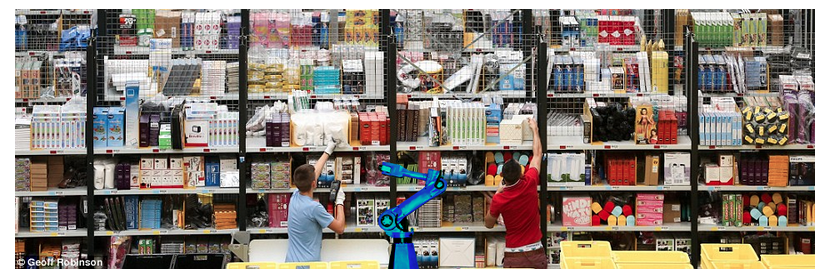
Picture from Amazon Picking Challange
Courtesy of Mish.
Amazon is sponsoring a robot warehouse automation contest to see to who can pack the most boxes in the least amount of time without dropping any packages or crushing anything delicate such as cookies.
In the contest, in which human workers are not eligible to apply, the robots will have to work without any remote guidance from their creators.
Please consider the MIT Technology Review, Amazon Robot Contest May Accelerate Warehouse Automation.
Packets of Oreos, boxes of crayons, and squeaky dog toys will test the limits of robot vision and manipulation in a competition this May. Amazon is organizing the event to spur the development of more nimble-fingered product-packing machines.
Participating robots will earn points by locating products sitting somewhere on a stack of shelves, retrieving them safely, and then packing them into cardboard shipping boxes. Robots that accidentally crush a cookie or drop a toy will have points deducted. The people whose robots earn the most points will win $25,000.
Amazon has already automated some of the work done in its vast fulfillment centers. Robots in a few locations send shelves laden with products over to human workers who then grab and package them. These mobile robots, made by Kiva Systems, a company that Amazon bought in 2012 for $678 million, reduce the distance human workers have to walk in order to find products. However, no robot can yet pick and pack products with the speed and reliability of a human. Industrial robots that are already widespread in several industries are limited to extremely precise, repetitive work in highly controlled environments.
Pete Wurman, chief technology officer of Kiva Systems, says that about 30 teams from academic departments around the world will take part in the challenge, which will be held at the International Conference on Robotics and Automation in Seattle. In each round, robots will be told to pick and pack one of 25 different items from a stack of shelves resembling those found in Amazon’s warehouses. Some teams are developing their own robots, while others are adapting commercially available systems with their own grippers and software.
The challenge facing the robots in Amazon’s contest will be considerable. Humans have a remarkable ability to identify objects, figure out how to manipulate them, and then grasp them with just the right amount of force. This is especially hard for machines to do if an object is unfamiliar, awkwardly shaped, or sitting on a dark shelf with a bunch of other items. In the Amazon contest, the robots will have to work without any remote guidance from their creators.
“We tried to pick out a variety of different products that were representative of our catalogue and that pose different kinds of grasping challenges,” Wurman said. “Like plastic wrap; difficult-to-grab little dog toys; things you don’t want to crush, like the Oreos.”
While the Amazon challenge might seem simple, Saxena believes it could quickly make an impact in the real world. “If robots are able to handle even the light types of grasping tasks the contest proposes,” he says, “we could actually start to see a lot of robots helping people with different tasks.”
The preceding MIT review describes the 2015 ICRA Contest May 26-30 in Seattle.
2014 Participant Video
…



